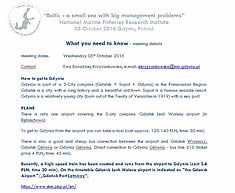Conference – “Baltic – a small sea with big management problems” Minister of Maritime Economy and Inland Navigation Secretary of State Marek Gróbarczyk On the 5th of October the National Marine Fisheries Research Institute held a conference under the title: “Baltic – a small sea with big management problems”, organized as part of the celebrations of this year’s 95th anniversary of the Institute. The conference aroused great interest not only in the country but also in other Baltic States. It was attended by over 200 people, including representatives of the fisheries sector. The proceedings were broadcast live by the Tri-City (Gdańsk–Sopot–Gdynia) Academic Computer Network known as TASK. They can be viewed on the NMFRI home page https://mir.gdynia.pl/baltyk-konferencja-baltyk-male-morze-ktorym-trudno-zarzadzac/?lang=en. As an important event taking place at the Institute, the conference began with striking the bell “Siedlecki” by the director of the Institute, Dr. Emil Kuzebski, who welcomed the attendees and outlined the basic assumptions of the conference. The Deputy Director of the Department of Fisheries, Kamil Wojnar, spoke on behalf of the Minister of Maritime Economy and Inland Navigation, the patron, as well as the sponsor of the conference, wishing the participants a fruitful and interesting meeting. The whole content-related part of the conference was moderated by prof. Tomasz Linkowski. The conference began with a very interesting lecture by Chistian Möllmann from the University of Hamburg entitled: “Regime Shifts induced by Climate and Overfishing in the Baltic Sea”. Professor Möllmann presented in an accessible manner the complex changes that have occurred and continue to occur in the Baltic Sea, caused mainly by the climate change, but also by the fisheries activity. In his research, the author took into account an enormous amount of biological, hydrological, and fisheries data. He showed that some changes may be reversible, while in case of other, a return to the original state is not possible. Changes in functioning of the ecosystem referred to as the “regime shifts” have undoubtedly an impact on the fisheries and the present problems are their consequence. Michael Naumann (Leibniz-Institute for Baltic Sea Research Warnemünde) presented “The intense inflow activity since 2014 – a succession of four major events and their impact on the Baltic Sea ecosystem”. In the period of 2014-2016, after ten-year intervals between the inflows of Atlantic waters into the Baltic Sea, we had several significant inflows, including one of the largest in history. It seemed that they should have a significant impact on the creation of favorable conditions for the spawning of cod. Nonetheless, the presented data indicate that such a process occurred, but only to a limited extent, because even though the salinity increased at the spawning grounds of cod, it was not necessarily connected with the proper oxygenation of bottom water layers, especially in the Gotland Basin. Looking through the window at the first ferocious autumn storm in the Baltic Sea, as well as analyzing data presented by the author on the density of inflows in recent years, one would like to hope that there is a chance to return to the period of 1960-1980, when the inflows occurred almost every year and which had its very positive impact on cod stocks. (Co-authors of the presentation are Günter Nausch and Volker Mohrholz from the same Institute) The presentation entitled: “Eutrophication of the Baltic Sea – problem seen from different prospects” – elaborated by Marianna Pastuszak from the NMFRI indicated how the correct research methodology is important and what measureable economic impacts it can have. The author, together with a team of colleagues, challenged the overestimated findings of the Helsinki Commission (HELCOM) related mainly to the loads of N (nitrogen) and P (phosphorus) discharged by the Polish rivers to the Baltic Sea. The adoption and implementation of the HELCOM findings by Poland would have very serious consequences for Poland, especially for Polish agriculture, as well as for the budget. The author presents a new look on the functioning of the Baltic Sea ecosystem, in particular highlighting among other things the fact of misunderstanding the definition of “eutrophication”, leading in a straight line to the wrong conclusions, in particular to the false conclusion that the Baltic Sea is eutrophied. She also pointed to the wrong linking of the “eutrophication” process with the trophic state and the lack of proper understanding and use of eutrophication indicators, as well as the omission of the very important role of silicon, the third macro-element, extremely important from the viewpoint of the “healthy functioning” ecosystem. (Co-authors of the presentation are Mariusz Zalewski, Tycjan Wodzinowski and Krzysztof Pawlikowski – NMFRI) “Review of fisheries management system in the Baltic states – The road to hell is paved with good intentions” – is the title of a lecture delivered by Michael Andersen (Danish Fishermen Producer Organization). According to the author the multiannual system of individual transferable quotas (ITQ) functions in the vast majority of the Baltic States (seven out of nine), but each country has its different specificity. It can refer to the vessels’ owners, producers’ organizations or companies. The author focused, however, on the system established and functioning in Denmark in both the pelagic and the cod fisheries. According to the author of the presentation, the system considers both the fact that the fisheries are the economic activities, as well as the social dimension. In Denmark, as in all countries where the ITQ system was introduced, there was a significant reduction in the fleet without using public funds. On the other hand, the economic efficiency of those who stayed in the fisheries sector improved substantially. When answering the question whether this has led to a reduction of coastal fisheries, he said that in his opinion the introduction of the ITQ system was one of the factors, but more important was the situation of resources, which currently exists in the Baltic Sea. In conclusion he said that the Danish system can still be improved, but thanks to it there are 1,000 happy owners of fishing vessels rather than 4,000 unhappy ones and therefore he believes it is a beneficial solution. The next presentation entitled “Genetics as a useful tool in stock management; whitefish example” was given by Anna Wąs-Barcz (NMFRI). Knowledge of the genetic structure is in the author’s opinion required for proper planning of restocking activities and whitefish is a species of great economic and social importance. The species is listed on the Red List of endangered and threatened species, published by the International Union for Conservation of Nature (IUCN), as well as it is also mentioned among endangered species on the HELCOM red list of the Baltic Sea. The main causes of the whitefish populations collapse in the Southern Baltic in the past century were unfavorable environmental conditions, leading to eutrophication and the related decrease in oxygen concentration, as well overfishing. Whitefish from the Szczecin Lagoon and the Puck bay as well as from the Curonian Lagoon, Lithuania, were genetically analyzed and the significant differences between the two populations were stated. As proven in this study, the restocking actions must be based on well-established genetic background; otherwise the potential profits may switch into loss. (Co-authors of the presentation are Wojciech Pelczarski – NMFRI and Tomasz Heese – Koszalin University of Technology) “Right-based management system in Baltic – results and experiences” is a title of a lecture delivered by Anton Paulrud – (Swedish Agency for Marine and Water Management in Göteborg). In October 2005 the Swedish Board of Fisheries proposed to introduce a new management system of the Swedish Pelagic fisheries based on Individual transferable quotas (ITQs). The aims of the reform were to support the structure of the fleet, to preserve the resources and secure an economically, environmentally, and socially sustainable fishing sector. According to the Operational Plan for the fishing industry in Sweden 2007-2013, the over-capacity in the pelagic fleet was around 30%, while the industry stated that this part of the fleet should be halved to achieve international competitiveness. The introduction of ITQs is in theory expected to reduce overcapacity and improve the economic performance of the fisheries. The system was gradually implemented starting with individual vessel quotas (IQ) in 2007, becoming transferable in November 2009, and resulting in a fully operational ITQ system. In addition to the shares of the quota distributed on a vessel level, there were also certain quantities for the coastal fisheries to preserve and strengthen the regional-based fisheries. This part of the quota cannot be subject to tradability. The effects of the ITQ system were immediate and significant: by the end of 2010 the number of pelagic vessels had halved and since then it is more or less stable. The results observed by introducing ITQ’s in the Swedish pelagic fisheries were substantial although expected according to economic theory and further support of earlier research results. The results also show that a well-designed ITQ system does not need to be a threat for small-scale communities. These empirical results provide valuable insights on how the ITQ system functions and eventually restructures fisheries and fishing fleets. Jacek Sadowski from the West Pomeranian University of Technology in Szczecin elaborated about “Perspectives of mariculture development in Polish Baltic coastal zone”. He pointed out that the history of mariculture in Poland dates back to the seventies of the last century, when the first attempts of cage culture of rainbow trout farming in the Gulf of Puck were made. For many years, the only form used in Poland mariculture was sea-ranching – actually stocking material production methods of marine fish aquaculture and stocking sea with them. These activities related to Atlantic salmon, sea trout and whitefish. The increased interest in world aquaculture has caused that also in Poland new opportunities to develop aquaculture were searched for. Unfortunately, due to the formation of the Polish Baltic Sea coast, the most commonly used mariculture methods cannot be implemented in Polish conditions. In the author’s opinion, the technology, which due to its relative independence from the marine environment is prospective for the Polish zone of the Baltic Sea, is land based aquaculture recirculation system, which can be mainly used for the production of Atlantic salmon, turbot and rainbow trout. An example of it is a farm of Atlantic salmon “Jurassic salmon” operating in Poland, which uses Jurassic submersible waters with the average salinity of 13 ppt. Marguerite Tarzia representing the BirdLife International, London, the United Kingdom made a presentation entitled “Bird bycatch in Baltic gillnet fisheries – the search for solutions”. Bycatch in gillnets is a major conservation issue for seabirds globally, with an estimated 400,000 mortalities in this gear type each year. The Baltic Sea is a ‘hot spot’, with an estimated 76,000 birds killed each year. The late autumn and winter are particularly problematic, as this is when high numbers of wintering seaducks coincide with active gillnet fisheries across the Baltic Sea. Unlike other fishing gears, such as longlines, where preventative measures have been developed and effectively introduced on board fishing boat, there has been little research dedicated to identifying potential solutions for gillnets. To this end, BirdLife International have been working with partners across the world, including directly with the fishing industry, to develop technical bycatch mitigation measures for gillnets. This presentation highlighted results of the work with sensory ecologists and Baltic fishermen to test prospective bycatch mitigation measures, with a view to finding a solution that works both for fishermen and for birds. “Perils of the sea – parasites transmitted by seals” is a topic presented by Magdalena Podolska (NMFRI). Parasitic infection in marine fish is a serious problem for the fishing industry in many countries. Cod is one of the fish species that is most heavily infected with anisakid nematodes in the North Atlantic and adjacent seas. In the last century, parasitic infection with anisakids affected cod in the Baltic Sea only marginally. However, infection levels have increased markedly in 2011–2016, particularly concerning the infection of cod with the liver worm Contracaecum osculatum. Several studies have revealed associations between the occurrence of grey seals and the level of infection of cod with the liver worm C. osculatum. The observed marked increase in the prevalence of infection in cod may correspond to an increase in numbers of the grey seal Halichoerus grypus in the Baltic Sea (from 10,300 in 2001 to 40,000 individuals in 2014). Both prevalence and intensity of infection increased with fish length up to 70–80 cm, but then began to decline, showing parabolic dependence. The decline may be attributed to increasing mortality of large and heavily infected cod. Poor condition of fish and the presence of anisakids in the liver may, in combination, have adverse consequences for the Baltic Sea population of cod. (Co-authors of the presentation are Jan Horbowy and Katarzyna Nadolna-Ałtyn from the NMFRI) “Economic effects of seal damages in Swedish coastal fisheries” – the lecture was presented by Staffan Waldo (AgriFood Economics Centre, Department of Economics, Swedish University of Agricultural Sciences). Small scale coastal fishing along the Swedish Baltic Sea coast is rapidly declining. This has consequences for cultural heritage in small fishing communities, and in the discussion on the causes of this phenomenon the issue of the growing seal population is often raised. Seals scare the fish, they feed directly from the nets, and they cause damage to the gear to an extent that is difficult for the fishing sector to handle. In a study of seal damages, a questionnaire was sent to Swedish fishermen in 2013 and 2014 where the fishermen were asked to provide information about the cost for mending and replacing gear that has been damaged by seals. It is interesting that completing questionnaires by fishermen was obligatory. The author presented an interesting and very comprehensive methodology for calculating losses caused by seals. The results were presented based on different gears and regions and compared to total revenues and other relevant economic indicators in order to determine the importance of damaged gear for the economic performance of the fishing sector. (Co-author of the presentation is Anton Paulrud from the same university as the author) Iwona Psuty (NMFRI) discussed issues related to “Fisheries in the context of spatial conflicts in the Polish Marine Areas”. The provisions establishing the framework for maritime spatial planning oblige all the Baltic countries to include the spatial development plans for their marine areas by 2021. In Poland in 2015 Study on conditions of the spatial development of Polish Marine Areas (PMA) with spatial analyses was created. In July 2016 proceedings relating to the creation of the plan began. The fundamental problem for fishers in the context of the PMA development plan is the fear that fisheries will be spatially limited. It will have to share space not only with shipping, but also with increasing number of investments, raw materials extraction, tourism and the marine environment protection. In addition, the priorities of designating space are not yet known. Fishers perceive this as an attack on the freedom to conduct their business. At the same time they are aware of spatial conflicts within their environment: controversy between the trawl fisheries and fishing with static gears in the coastal zone (3-6 NM from the coast) has always aroused strong emotions. Spatial planning is often viewed by fishers as a tool for lobbying by energy companies planning to invest in offshore wind farms. In addition, the plans for protection of Natura 2000 sites are perceived by fishers as a real threat. These areas cover almost the entire coastal zone, and due to the gaps in knowledge and adopted precautionary approach, these plans involve significant restrictions on fishing with static gears. On the other hand, there are gaps in the information about the most important fishing grounds, for which the marine space should be protected. Only approx. 20% of the Polish fishing vessels (over 12 meters in length) are equipped with the VMS (Vessel Monitoring System) allowing to determine their routes, and combined with the data contained in logbooks, it is possible to perform analysis of the fishing effort and the volume of catches in high spatial resolution. The majority of the Polish fleet is vessels of up to 12 meters, which report the fishing effort and catches in the resolution of a fishing statistical square, i.e. approximately 20 x 20 km2. Without more accurate determination of priority fishing grounds for fisheries, the true scale of conflicts with other types of activity at sea is unknown. This gives rise to the feeling of threat and protests against limiting fishing activities. (Co-authors of the presentation are Marcin Rakowski, Lena Szymanek and Maciej Adamowicz from the NMFRI) Text: Z. Karnicki. 09:00-09:45 Conference registration & welcome coffee 09:45-10:00 Opening ceremony Moderator: Prof. Tomasz Linkowski 10:05-10:45 Opening lecture: 10:45-11:25 Session 1- Environment: 11:25-12:00 Coffee break 12:00-13:20 Session 2 – Management and challenges: 13:20-14:30 Lunch 14:30-15:40 Session 3 – Threats: 15:50-16:20 Conference summary and discussion Conference “Baltic – a small sea with big management problems” co-financed under the agreement No. 12/P-DUN/2016 by the Ministry of Science and Higher Education allocated to the activities of disseminating science and by the Ministry of Maritime Economy and Inland Navigation Secretary of State. Meeting dates: Wednesday 05th October 2016 Contact: Ewa Baradziej-Krzyżankowska, e-mail: ekrzyzankowska@mir.gdynia.pl How to get to Gdynia Gdynia is part of a 3-City complex (Gdańsk + Sopot + Gdynia) in the Pomeranian Region. Gdańsk is a city with a long history and a beautiful old town. Sopot is a famous seaside resort. Gdynia is a relatively young city (born out of the Treaty of Versailles in 1919) with a sea port. PLANE To get to Gdynia from the airport you can take a taxi (cost approx. 120-140 PLN; time: 30 min). There is also a good and cheap bus connection between the airport and Gdańsk Wrzeszcz; Gdańsk Główny or Gdynia Główna. Direct connection to Gdynia Główna – bus line 4A (ticket price 4 PLN; time: 45 min). Recently, a high speed train has been created and runs from the airport to Gdynia (cost 3-6 PLN; time 20 min). On the timetable Gdansk Lech Walesa airport is indicated as “the Gdansk Airport.”/„Gdańsk Port Lotniczy” FERRY TRAIN BUS 3-CITY TRAIN ZKM Gdynia http://www.zkmgdynia.pl/ ZTM Gdańsk http://www.ztm.gda.pl/en/index.php/ztm/more/about Meeting location: VENUE – NATIONAL MARINE FISHERIES RESEARCH INSTITUTE Conference room: HOTEL – MERCURE GDYNIA CENTRUM RECEPTION DESK (reservation inquiries): Accommodation: Special rates available when quoting “Baltic Conference” during the booking: Single room with breakfast: 260PLN Superior Room : +35PLN to the basic rate Check-in 14:00. Check-out 12:00. A few hotels to your decision: Nadmorski Hotel: http://nadmorski.pl/hotel-en/ “Gdynia is a city built of Sea and Dreams”. You can find further information: Gdynia by night Hotel Mercure Gdynia Centrum, a seaside hotel situated in a prestigious location in the very heart of Gdynia. The hotel is situated 100 m from the beach and 15 min walking from the Main Train Station. The hotel offers 294 smoke free rooms. The shopping district (Swietojanska Str.) is 5 minutes’ walk away. The Musical Theatre, Multikino cinema-shopping complex, Kosciuszko Square, Seaside Boulevard, the Museum of the City of Gdynia and the Naval Museum are all nearby and there are many pubs, taverns, coffee bars and other attractions. See you in Gdynia in OctoberConference details
National Marine Fisheries Research Institute
05 October 2016 Gdynia, Poland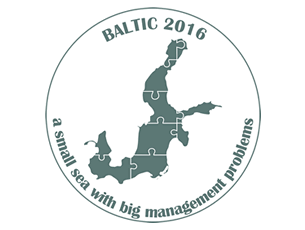
Recordings
The honorary patronage
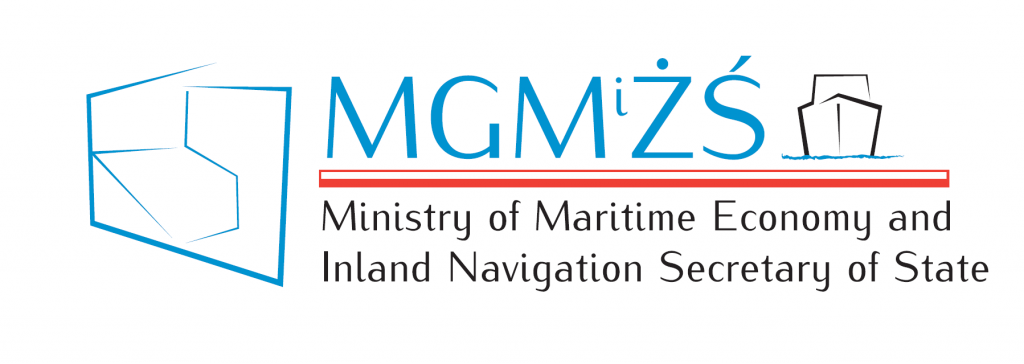
Summary
The Scientific Committee
Agenda


Meeting details
There is only one airport covering the 3-city complex: Gdańsk Lech Walesa airport (in Gdańsk – Rębiechowo).
There is a direct ferry connection to Gdynia from Helsinki or Karlskrona.
Gdynia and Gdańsk are also important railway stations for international trains (for example from Berlin, Vienna or Kaliningrad).
There is also an international bus connection from many European cities to Gdańsk or Gdynia.
The easiest, the fastest and the cheapest way of travelling between the 3-city complex is the Urban Fast Train (SKM). You can buy a ticket in the ticket office, newsstand or directly from the ticket machine that is on (or nearby) every SKM platform. Please be aware that the tickets bought in the ticket office or newsstand need to be validated in the ticket puncher that is on (or nearby) every SKM platform BEFORE You enter the SKM train. Tickets bought from the ticket machine (available language versions on the screen: English, German, Polish) are already validated. The tickets are validated only for the next SKM train. The price for the ticket from Gdynia Główna to Gdańsk Główny is 6 PLN; time: 40 min. Every city also has its own bus line network. Tickets and prices differ between the cities.
KAZIMIERZ DEMEL CONFERENCE ROOM
ADDRESS : ul. Kołłątaja 1, 81-332, Gdynia, Poland


ADDRESS: ul. Armii Krajowej 22, 81-372 Gdynia
tel. +48 58 666 29 10
fax. +48 58 666 28 50
e-mail: H3417-re1@accor.com
http://www.mercure-gdynia-centrum.com


Double room with breakfast: 300PLN
Privilege Room : +70PLN to the basic rate
Różany Gaj Hotel: http://www.rozanygaj.pl/
Hotton Hotel: http://hotton.pl/en/
Villa Admirał: http://www.admiralvilla.com.pl/pl/

Conference – “Baltic – a small sea with big management problems”
Opublikowano 22 October 2016


